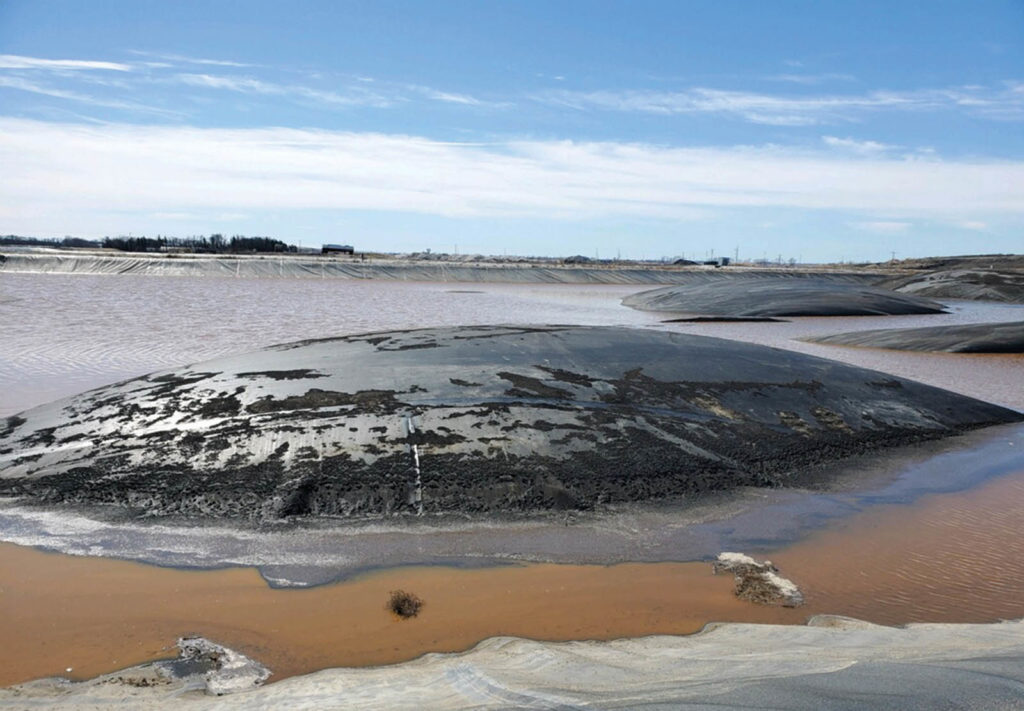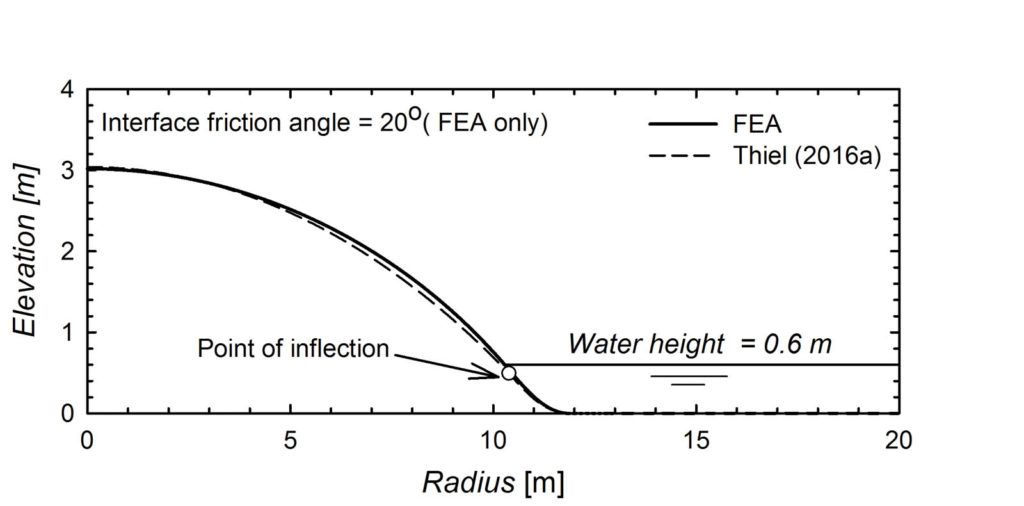By Richard Thiel, Hesham Eldesouky and Richard Brachman

This article provides an update, validation and improved approach for predicting the shape, pressure and strains that can occur in an exposed geomembrane bubble (aka “whale”) created by gas trapped below the geomembrane in a pond (Figure 1). The October/November 2017 issue of Geosynthetics magazine presented an article by Thiel (2017) that provided analytical methods to predict the shape, pressure and strain of gas bubbles that often occur in ponds with exposed geomembrane liners. Two follow-up articles were presented in the February/March 2018 and April/May 2018 issues of Geosynthetics magazine (Thiel 2018a and 2018b) that discussed the design and operational approaches for exposed geomembrane pond liners that should be considered in light of the understandings gained related to the mechanics of these bubbles. The method was based on the assumption that the portion of the bubble above the point of inflection was circular, while the portion below the point of inflection was a clothoidal spiral. The stresses and strains in the geomembrane bubble were estimated by summing the forces in the vertical direction based on the derived geometry using an iterative calculation approach to reach a solution. The method, which can be referred to as an “approximate static-equilibrium model,” was not able to account for the influence of the interface friction between the geomembrane and the subgrade, nor for a realistic continuity of strain variations throughout the bubble and into its merge with the subgrade. The details of the calculations were provided by Thiel (2016) in a manner that could be replicated in a spreadsheet.
Recent finite element analysis (FEA) modeling of this problem was performed by Queen’s University in Kingston, Ont., Canada. The results of the FEA modeling were found to be relatively close to the approximate static-equilibrium model and provided a continuity in the strain along the bubble surface that continued into the surrounding free-field geomembrane on the pond floor. The FEA results were able to show the changes in bubble pressure and strain distribution depending on the assumed interface friction between the geomembrane and the pond subgrade material below the geomembrane.
Comparing the calculated bubble shape predicted by the FEA analysis with the approximate static-equilibrium approach developed by Thiel (2016) indicated very close agreement for the same bubble height, width and depth of water. For the example investigated, the agreement was closest when an interface friction angle of 20° between the geomembrane and the subgrade was implemented in the FEA. A comparison of the results for a single case is presented in Figure 2. In addition to the predicted bubbles’ shapes that were very close, the following quantitative comparison of results of calculated pressures and strains was also obtained:

The calculated internal bubble pressure, P, by the approximate Thiel (2016) approach was 0.15 psi (1.03 kPa) compared to 0.14 psi (0.95 kPa) by the FEA method (8.4% difference).
The calculated volume of the bubble, V, by the approximate Thiel (2016) approach was 21,613 cubic feet (612 m3) compared to 22,884 cubic feet (648 m3) by the FEA method (5% less).
The strain estimated by the Thiel (2016) method for the zone above the waterline was 3.95%, while FEA results show the strain varying from 3.0% at the pole to 3.7% at the waterline.
Thus, the “simplistic spreadsheet model” is more conservative than the FEA model, but still relatively accurate, at least for the investigated example.
It is remarkable that the simplified spreadsheet approach, Thiel (2016), is similar to the FEA method, given that the two methods were based on completely unique and independent approaches. The Thiel (2016) method could only assume average strains in discrete zones of the bubble, with unrealistic step functions in the strain estimates along the bubble profile, and unrealistic values of strains in certain portions of the bubble. However, the FEA method (i) takes into account bottom friction of the liner with the subgrade, and (ii) describes a continuity of strain throughout the bubble profile extending it into the free-field geomembrane surrounding the bubble. The correspondence between the two methods to describe the shape, pressure and strains in geomembrane bubbles provides a validation of their relative accuracy, which is also corroborated by field observations.
Additional updates on the FEA method for pond bubble analysis and parametric studies are being submitted as a paper for the upcoming EuroGeo7 conference scheduled to occur in Warsaw, Poland, in May 2021.
Richard Thiel is the president of Thiel Engineering in Oregon House, Calif.
Hesham Eldesouky is a post-doctoral fellow in the Geo-Engineering Center at Queen’s University in Kingston, Ont., Canada.
Richard Brachman is a professor in the Geo-Engineering Center at Queen’s University in Kingston, Ont., Canada.
References
Thiel, R. (2016). “Analysis of stresses and strains in geomembrane gas bubbles that occur in surface impoundments.” Proc., Geo-Chicago 2016, American Society of Civil Engineers, Chicago, Ill.
Thiel, R. (2017). “Design of exposed geomembrane lined ponds: Controlling uplifting gas bubbles,” Part I. Geosynthetics, 35(5), 42–49.
Thiel, R. (2018a). “Design of exposed geomembrane lined ponds: Controlling uplifting gas bubbles,” Part II. Geosynthetics, 36(1), 36–42.
Thiel, R. (2018b). “Design of exposed geomembrane lined ponds: Controlling uplifting gas bubbles,” Part III. Geosynthetics, 36(2), 10–18.
 TEXTILES.ORG
TEXTILES.ORG


